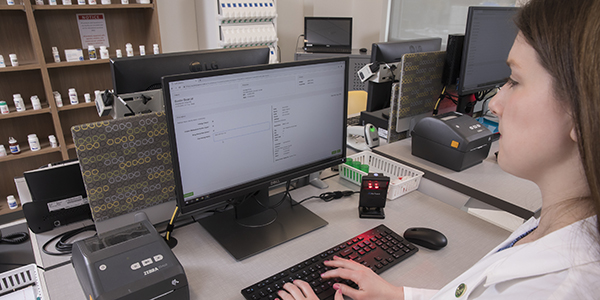New software helps make practicing perfect
Teaching counting, pouring, licking and sticking

Sarah Lynch wants Binghamton’s pharmacy graduates to feel confident from the very first day of their initial clinical placements. That’s why she and her colleagues are building unique software that emulates the systems professionals use to dispense medications and maintain medical records.
“This is a challenge for healthcare education programs,” says Lynch, director of skills education and a clinical assistant professor of pharmacy practice. “The system itself is not the learning objective. Wherever you go, it’s going to be different. But it’s such an integral part of the way we practice nowadays that you need a system that’s going to be intuitive and easy to use.”
Lynch worked with a team at the School of Pharmacy and Pharmaceutical Sciences as well as Information Technology Services to develop two programs. Her collaborators include William “Fritz” Sticht, skills education technician; Adam Smallcomb, applications development analyst; and Tim Cortesi, assistant director of technology support services. They created the software and integrated it into the campus’ myBinghamton web portal.
Dispensing software allows pharmacists to monitor medication records at the pharmacy level. “We can see all of the medications a patient is using,” Lynch says. “We can track conditions, allergies, which doctors are prescribing, refill adherence, all of those things.”
When they sign in to Binghamton’s dispensing program, students see a screen like they’d have at a pharmacy. There’s a prescription from the healthcare provider, which the students use as a reference when they create a label to go onto the bottle that will be given to a patient. Students review the quantity, the expiration date and instructions about how and when to take the medicine.
A candy formulary at the simulation lab allows students to check their work. M&M’s, Skittles and other colorful sweets are in bottles and ready for barcode scanning.
Pharmacy students have a two-week site rotation in the summer following their first year of school. Simulations help to level the playing field between students who have had previous work, volunteer or internship experiences in a pharmacy and those who haven’t.
“Our goal is to get them used to the idea of a pharmacy workflow, to have them understand some of the vocabulary that’s related to it,” Lynch says. “I don’t know of a good way to do that via a lecture.”
The process of dispensing is straightforward, what a professional might think of as “count, pour, lick, stick,” Lynch says.
So why spend so much time on it? “The value of the system comes from challenging the students to apply all of the clinical knowledge they’ve learned in a real-life setting,” she explains.
The dispensing software earned solid reviews from the first students who used it. Lynch surveyed them about their change in comfort level with a few of the objectives related to the dispensing software. Almost three-quarters of reporting students felt more comfortable putting patient-friendly directions on the prescription label after doing the activity.
Soon, the Binghamton team will debut its educational electronic medical record system, too.
Electronic medical records, or EMRs, are typically used in a clinic or hospital. They connect all the healthcare providers in a particular setting.
There are several commercially available educational EMR systems. In fact, Binghamton is using one now. However, they don’t allow multiple members of an inter-professional team to interact with the same patient. Lynch and her colleagues want student pharmacists, nurses and social workers to be able to interact with the same patient and communicate via the notes in the EMR.
Not only will the EMR program inject a note of realism into their coursework, it will also save students money. Off-the-shelf solutions typically come with a fee of about $100 per student.
The pharmacy school’s simulation labs include a clinical setting with medical mannequins. Next door, there’s a practice space that resembles an in-patient pharmacy. Right next to that, there’s a community pharmacy workspace. On the counters in the brightly lit room are verification stations, complete with phones, counting trays and Kirby Lester pill counters. Nearby, pill bottles line the shelves.
“Most schools don’t have a practice space like this,” Lynch notes. “Students here can do an actual workflow instead of watching a PowerPoint.”
Soon, with support from a SUNY grant, the dispensing program as well as the EMR software will be available to students from other campuses as well as at Binghamton.
The simulations allow Lynch and her colleagues to start with basic elements and add layers for more advanced students. “As an educator, my goal is not to teach the students how to use the technology,” she says. “It’s to have the technology be intuitive enough so that it becomes a tool for teaching the clinical skill I want them to learn.”
